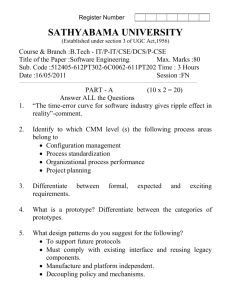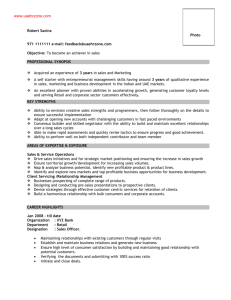Document 10300196
advertisement
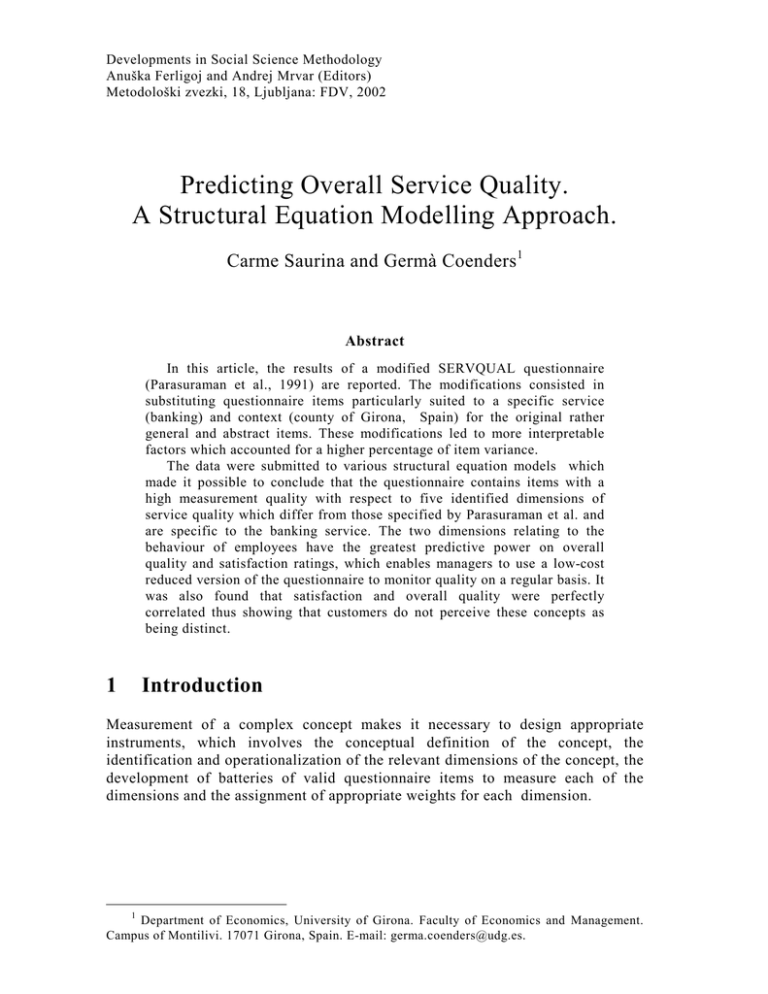
Developments in Social Science Methodology Anuška Ferligoj and Andrej Mrvar (Editors) Metodološki zvezki, 18, Ljubljana: FDV, 2002 Predicting Overall Service Quality. A Structural Equation Modelling Approach. Carme Saurina and Germà Coenders1 Abstract In this article, the results of a modified SERVQUAL questionnaire (Parasuraman et al., 1991) are reported. The modifications consisted in substituting questionnaire items particularly suited to a specific service (banking) and context (county of Girona, Spain) for the original rather general and abstract items. These modifications led to more interpretable factors which accounted for a higher percentage of item variance. The data were submitted to various structural equation models which made it possible to conclude that the questionnaire contains items with a high measurement quality with respect to five identified dimensions of service quality which differ from those specified by Parasuraman et al. and are specific to the banking service. The two dimensions relating to the behaviour of employees have the greatest predictive power on overall quality and satisfaction ratings, which enables managers to use a low-cost reduced version of the questionnaire to monitor quality on a regular basis. It was also found that satisfaction and overall quality were perfectly correlated thus showing that customers do not perceive these concepts as being distinct. 1 Introduction Measurement of a complex concept makes it necessary to design appropriate instruments, which involves the conceptual definition of the concept, the identification and operationalization of the relevant dimensions of the concept, the development of batteries of valid questionnaire items to measure each of the dimensions and the assignment of appropriate weights for each dimension. 1 Department of Economics, University of Girona. Faculty of Economics and Management. Campus of Montilivi. 17071 Girona, Spain. E-mail: germa.coenders@udg.es. 218 Carme Saurina and Germà Coenders These steps have been followed for service quality measurement during the last two decades. The conceptual definition usually links service quality to the customer perceptions of the level of excellence of the service provided (Zeithaml, 1986). Parasuraman et al. (1985, 1988, 1991) define perceived quality as a gap between consumers’ expectations and consumers perceptions regarding the service. This definition can be related to the multiple discrepancies theory developed in the field of social psychology to define satisfaction with life (Michalos, 1985). Quality and satisfaction are distinctly defined though obviously related. Perceived quality is a form of attitude, and results from comparing expectations with perceptions of performance (Parasuraman et al., 1988). According to Oliver (1981, page 42), “Attitude is the consumer’s relatively enduring affective orientation for a product, store, or process (e.g., customer service) while satisfaction is the emotional reaction following a disconfirmation experience which acts on the base attitude level and is consumption-specific”. Michalos’ multiple discrepancies theory defines life satisfaction as a function of seven gaps (with what others have, what one feels to deserve, what one needs, what one wants, what one had and expected to have 3 years ago, what one expects to have 5 years in the future, and the best one has ever had in the past). These gaps can be established for all relevant dimensions or domains of life which, according to Michalos, are health, financial security, family relations, employment, friendship, housing, neighbourhood, recreation, religion, self-esteem, transportation and education. Michalos suggested asking respondents to evaluate gaps directly. Parasuraman et al. (1985) define a set of gaps occurring at different stages of the service design and provision, which altogether result into the ultimately relevant gap between consumers’ expectations prior to the service delivery and consumer perceptions during the service delivery. This gap was first defined for 11 dimensions or domains of the service provision (access, competence, responsiveness, reliability, courtesy, communication, credibility, security, understanding and knowing the customers, and tangible), which were later reduced to five (responsiveness, reliability, assurance, empathy and tangible) by Parasuraman et al. (1985). The authors reported that these domains consistently emerged in services of different nature, which, according to them, argues for their generalizability. The questionnaire designed by Parasuraman et al. (SERVQUAL) asked respondents separately about expectations and perceptions in comparable scales so that gaps can be simply obtained by subtracting perceptions from expectations. The SERVQUAL model has been widely used (Buttle, 1996) but has also been seriously criticised so that no consensus has been reached about a number of relevant questions: 1. Are the suggested domains consistent? Many empirical applications fail to recover the five dimensions and suggest to modify them (Babakus & Boller, 1992; Carman, 1990; Cronin & Taylor, 1992; Parasuraman et al., 1994a) 2. How are gaps best measured? When using a direct question as suggested by Michalos (1985) it is questionable whether the middle point of the response Predicting Overall Service Quality… 219 scale precisely represents the absence of a gap. When using subtraction as suggested by Parasuraman, it is still questionable what expectations mean and whether perceptions have already an implicit comparative nature and can be used as measures of gap on their own (Cronin & Taylor, 1994; Saurina, 1997a). Besides, the convenience of asking about expectations and perceptions in a single interview session has also been questioned (Carman, 1990). 3. Are the concepts of satisfaction and quality really different? If so, what is the relationship among them? According to Anderson et al. (1994), Cronin and Taylor (1992), Llorens (1996) and Reidenbach and SandiferSmallwood (1990) quality precedes satisfaction. According to Bitner (1990), Bolton and Drew (1991), Carman (1990), Parasuraman et al. (1985) and Teas (1993), satisfaction precedes quality. According to Oliver (1981), satisfaction is an intervening variable that mediates the formation of new quality perceptions from previous ones. According to McAlexander et al. (1994) and Saurina, (1997a, 1997b) there may fail to be enough empirical evidence in favour of any of the aforementioned views. 4. Is the SERVQUAL questionnaire useful for any service? Many versions of the questionnaire have been suggested. For instance, Parasuraman et al. (1988, 1991) used a 22-item version for banks, credit card companies, repair and maintenance companies and telephone companies. Carman (1990) used a 16-item questionnaire for a dental clinic, a 32-item one for a placement centre, a 21-item one for a tyre store and a 26-item one for a hospital. 5. Are domains stable in time and consistent across cultures? Varying degrees of fit of the factor analysis model (overall percentages of explained variance ranging from 56% to 71%) were reported (Parasuraman et al., 1988, 1991). Saurina (1997a, 1997b) first applied the SERVQUAL instrument to evaluate the quality of banking services in the county of Girona (Spain). The SERVQUAL questionnaire as in Parasuraman et al. (1991) was independently translated into the Catalan language several times, and translated back into English to ensure functional equivalence of the translated and original questionnaire items (Nord & Sparrow, 1991). As opposed to what is common practice, the questionnaire was not administered to customers of a particular bank but to an n=430 representative sample of the population in the area, obtained by simple random sampling, stratified by town and using the census as sampling frame (see for instance Kish, 1965). The data were collected by personal interviews in the respondent’s homes, which is generally considered superior to self-administered questionnaires for perceptual and attitudinal surveys of general populations when low social desirability bias is to be expected (Groves, 1989). The main conclusions drawn from this study were: 1. The translated SERVQUAL questionnaire failed to reveal five dimensions accounting for a large percentage of variance of the questionnaire items (explained variances were 52%, 51% and 45% for perceptions, expectations 220 Carme Saurina and Germà Coenders and gaps respectively). In addition, none of the common factor rotation methods led to factor patterns from which the dimensions suggested by Parasuraman et al. (1991) could be interpreted. This was so for perceptions, expectations and gaps. These results suggest that the questionnaire may lack relevant items and that the five dimensions may need to be redefined. 2. The five extracted perception factors accounted for a higher percentage of variance of direct overall quality and overall satisfaction ratings (45% and 48%) than the five extracted gap factors (34% and 36%), thus suggesting that perceptions constitute better predictors of quality. Unless the conceptual link between gaps, quality and satisfaction is questioned, this result suggests that perceptions are comparative rather than absolute, so that no other measure of gap is needed. These findings constitute true depth charges to the whole SERVQUAL model. These conclusions argue for the need of a second survey of the same population (county of Girona) and of the same service (Banking) using a deeply adapted version of the questionnaire, which departs from the SERVQUAL design but which is much better suited for the particular service and cultural setting. Such an adapted questionnaire should enable us to: 1. use only perception items. 2. redefine a number of perception domains in such a way that they better reflect the situation of the particular service and they better predict criterion variables such as overall satisfaction ratings and a behavioural intention which can be related to customer fidelity. 3. redraw the batteries of perception items, which are used to measure each domain and evaluate the measurement quality of each item. 4. rank the importance or weight of domains for predicting the criterion variables. 5. suggest a low-cost reduced version of the questionnaire made up with the best perception items of the most relevant domains which can be used by firms to monitor the evolution of quality on a regular basis. 6. shed new pieces of evidence regarding the relationship between overall quality and overall satisfaction ratings. 2 2.1 Methodology Questionnaire The questionnaire used in Saurina (1997a, 1997b) has been modified in order to better account for the aspects of the service which are relevant to banking according to the usual business practices in the county of Girona. In the whole of Catalonia, where Girona is located, there is a particular tradition of personal banking, in which small saving banks that can provide a direct and friendly contact Predicting Overall Service Quality… 221 have the largest market share. This banking style is also influenced by the fact that the largest town in the county has less than 100,000 inhabitants. The level of generality and abstraction of the SERVQUAL is no longer necessary if only one service and one context lies within the researchers’ interest. This enabled us to word the questionnaire items in particular rather than general and concrete rather than abstract terms, which made them more easily understandable to respondents of the general population. In-depth interviews with banking agency directors were conducted with this purpose. Other changes introduced to the questionnaire were to: 1. introduce a weak no-opinion filter by offering a “don’t know” option to the perception items. Such no opinion filters are strongly recommended in the survey literature whenever it can be expected that a significant proportion of the population does not hold strong opinions on the topic of interest (Zaller, 1992). 2. word items in a language as close as possible to colloquial. 3. shorten or split lengthy and double-barrelled items. The questionnaire was pilot tested on an n=30 sample which was heterogeneous enough in terms of age, educational level, occupation and town size. A battery of debriefing questions was added at the end of the questionnaire to elicit the understanding of the meaning of the perception items. The pilot test suggested to introduce a number of further modifications into the questionnaire, such as to: 1. 2. 3. 4. further shorten and clarify complex or confused items. drop three items which were perceived as redundant with other items. drop one item which was too general and ambiguous. drop one item which was associated to bad quality by a considerable part of the respondents. 5. substituting a concrete item for an abstract one. The 19 perception items used in Saurina (1997a) were a subset of the 22 items in Parasuraman (1991) and are shown in the appendix together with the 18 items of the final adapted questionnaire. All items had nine-point Likert-type response scales. The extreme categories were labelled “completely disagree” and “completely agree”. A descriptive report of the data, including a market segmentation, is to be found in Saurina et al. (2001). 2.2 Sample and data collection The questionnaire was not administered to customers of a particular bank but to an n=312 representative sample of the population in the area, obtained by systematic sampling, stratified by town and using the telephone directory as sampling frame, after dropping numbers which could be clearly attributed to businesses or public offices. The original sample size was larger in order to compensate for vacant 222 Carme Saurina and Germà Coenders homes due to death, changes of residence or to the fact that a considerable number of housing units in the county of Girona belong to non-residents and are only used during the summer holidays. The data were collected by personal interviews in the respondent’s homes. Kish’s table (Kish, 1965) was used to randomly select the person to be interviewed among the adults living in the household. One recall was made when the house was empty or the selected person was not in. The item-level data missingness averaged 9.5% and was treated by means of regression imputation. 11 extreme outliers were identified by means of the Mahalanobis distance and appeared as single-case groups in a preliminary cluster analysis. Thus, a n=301 complete data set was produced and could be submitted to the analysis. 2.3 Structural equation modelling Structural equation models with latent variables (SEM) are more and more often used to analyse relationships among variables in marketing and consumer research (see for instance Bollen, 1989; Schumacker & Lomax, 1996, or Batista-Foguet & Coenders, 2000, for an introduction and Bagozzi, 1994 for applications to marketing research). Some reasons for the widespread use of these models are their parsimony (they belong to the family of linear models), their ability to model complex systems (where simultaneous and reciprocal relationships may be present, such as the relationship between quality and satisfaction), and their ability to model relationships among non-observable variables (such as the domains in the SERVQUAL model) while taking measurement errors into account (which are usually sizeable in questionnaire data and can result in biased estimates if ignored). As is usually recommended, a confirmatory factor analysis (CFA) model is first specified to account for the measurement relationships from latent to observable variables. In our case, the latent variables are the five perception dimensions and the observed variables the 18 perception items. The relationships among latent variables cannot be tested until a well-fitting CFA model has been reached. In our case, the relationships among overall quality, overall satisfaction, a reported behavioural intention and the perception dimensions are of interest. This modelling sequence stresses the importance of the goodness of fit assessment and of the re-specification of bad-fitting models. According to the usual procedures, the goodness of fit is assessed by checking the statistical and substantive validity of estimates (i.e. that no estimates lie out of the admissible range, as the case is for negative variances or correlations larger than one, and that no estimates lack a theoretical interpretation, as the case is for estimates of unexpected sign), the convergence of the estimation procedure, the empirical identification of the model, the statistical significance of the parameters, and the goodness of fit to the covariance matrix. Since complex models are inevitably misspecified to a certain extent, the standard χ 2 test of the hypothesis of perfect fit to the population covariance matrix is given less importance than measures of the degree of approximation between the model and the population covariance matrix. The root mean squared error of approximation (RMSEA) is Predicting Overall Service Quality… 223 selected as such a measure. Values equal to 0,05 or lower are generally considered to be acceptable (Browne & Cudeck, 1993). The sampling distribution for the RMSEA can be derived, which makes it possible to compute confidence intervals. These intervals allow researchers to test for close fit and not only for exact fit, as the χ 2 statistic does. If both extremes of the confidence interval are below 0.05, then the hypothesis of close fit is rejected in favour of the hypothesis of better than close fit. If both extremes of the confidence interval are above 0.05, then the hypothesis of close fit is rejected in favour of the hypothesis of bad fit. The respecification of bad-fitting models is done by: 1. dropping loadings which are not substantively interpretable. 2. adding loadings which are both interpretable and statistically significant. 3. splitting dimensions for which interpretable clusters of positive residual correlations appear. 4. adding error correlations which are both interpretable and statistically significant. 5. dropping items which would load on nearly all dimensions. 6. merging dimensions whose correlation is close to unity. 7. dropping non-significant regression coefficients among latent variables. In order to account for measurement errors, one must either provide at least two indicators for each latent variable or know or assume the reliability coefficient of the indicator in advance, so that the non-identified factor loading and error variance of the item can be appropriately constrained. The latter holds for overall quality, overall satisfaction, and the reported behavioural intention. In order that the constraints on the loadings of these variables be realistic, we predict the reliability coefficient from the meta-analysis of measurement quality in personal interviews carried out in Austria by Költringer (1995). According to this metaanalysis, the average reliability coefficient is 0,88. To predict reliability of a particular questionnaire item, this average should be modified according to the characteristics of the questionnaire, the data collection and the nature of the variable of interest (see Költringer, 1995, for details). In our case we must: 1. add 0.01 as the response scales have 9 or more scale points. 2. add 0.04 as the texts of the questions and the introductions to the questions are short. 3. add 0.01 as the questions’ contents are attitudinal but unlikely to be sensitive to social desirability. 4. subtract 0.02 as the questions belong to a battery of similar items. 5. subtract 0.03 as the questions are not among the first in the questionnaire. 6. subtract 0.01 as non-professional interviewers administered the questionnaire. The predicted reliability coefficient is thus 0,88. This estimate is of course not completely accurate, as it only constitutes a prediction and is based on data obtained in a different country. However, it is likely more reasonable than the 224 Carme Saurina and Germà Coenders customary estimate of 1, which is implicitly used whenever fitting models which do not take measurement errors into account. The models were estimated by normal theory maximum likelihood using the LISREL8.3 program (Jöreskog & Sörbom, 1989, 1993; Jöreskog et al. 1999) taking the covariance matrix as input. The robustness maximum likelihood point estimates to non-continuous measurement (such as those obtained with nine-point Likert items) is well documented for models which include measurement error terms such as those considered in this article (Coenders et al., 1997; Homer and O’Brien, 1988; Johnson & Creech, 1983). However, non-continuous data do deviate from the normality assumption, which does affect the quality of inferences. The computation of the χ 2 statistic and the RMSEA have been based on the mean scaling corrections developed in Satorra and Bentler (1994) that render them robust to non-normality. These corrected statistics are available in LISREL8.3 (Jöreskog et al., 1999). Likelihood ratio tests among nested models can be computed as χ2 differences. Unfortunately, the difference between two mean-scaled χ2 statistics is not χ2 distributed, though some easy adjustments can be made by hand (Satorra & Bentler, 1999). Let T*0 and T*1 be the mean-scaled χ2 statistics, c0 and c1 the scaling constants obtained as c0 =T0/T*0 and c1 =T1/T*1, and d0 and d1 the degrees of freedom for two nested models, of which Model 0 is more restrictive. The robust χ2 difference can be computed as: Robust χ 2 difference = 3 3.1 T0 − T1 d 0 c0 − d1c1 ( d 0 − d1 ) Results CFA model The first CFA model which was fitted specified the 5 dimensions defined by Parasuraman and the batteries of perception items of the final questionnaire, shown in the second column of the appendix. Item numbers in the appendix and the diagrams only show the order in which they were presented in the questionnaire. The path diagram of the aforementioned model is depicted in Figure 1, together with the χ 2 statistic, the confidence interval (C.I.) for the RMSEA and the standardised parameter estimates. For this model, all factor correlations were above 0.95 (7 of them were even inadmissibly above 1). This might be considered to be an argument for the unidimensionality of the quality construct, which has been sometimes suggested (e.g., Cronin & Taylor, 1992). However, the unacceptably large RMSEA rather shows that even more dimensions would be necessary to account for the item correlations and suggests that factor correlations may be so high because of misspecification bias. Predicting Overall Service Quality… χ2=596.94, d.f.=125, p-value=0.000 225 90% CI for RMSEA: (0.10, 0.12) Figure 1: CFA model of the dimensions defined by Parasuraman. Standardised estimates. 226 Carme Saurina and Germà Coenders χ 2 =348.83, d.f.=129,p-value=0.000 90% CI for RMSEA: (0.066, 0.085) Figure 2: Starting CFA model. Standardised estimates. Predicting Overall Service Quality… χ 2 =119.96, d.f.=84, p-value=0.006 227 90% CI for RMSEA: (0.021, 0.052) Figure 3: Modified CFA model. Standardised estimates. 228 Carme Saurina and Germà Coenders We considered the model in Figure 1 to be too poor as a starting point for a specification search process. Therefore we carried out a four-factor principal axis exploratory factor analysis with varimax rotation and specified a new CFA model relating each item to the factor with highest loading in the exploratory factor analysis model. This model is depicted in Figure 2, fitted considerably better than the original model and yielded a maximum factor correlation of 0.87. The fit could be further improved by following the model modification guidelines described in the foregoing section, which lead to the model in Figure 3. The goodness of fit is now acceptable, the upper limit of the C.I. for the RMSEA being only slightly above 0.05. All factor loading and error covariance estimates are statistically significant. In addition, all factor correlations are significantly different from unity, thus showing that none of the five dimensions can be merged to another. Nevertheless, all factor correlations are rather high, (between 0.63 and 0.89) as was to be expected since all factors are related to the common construct of service quality. The new factor pattern in Figure 3 shows important differences with respect to that in Figure 1. 5 dimensions are now present, which we have labelled competence, information, employee1, employee2 and tangible. If we compare both patterns we see that: 1. items p12 “XYZ’s Employees inform you of major topics related to financial operations such as deadlines, taxes, commissions” and p15 “XYZ has operating hours convenient to you” would load on nearly all 5 dimensions and were dropped from the model. 2. the competence dimension is related to two items formerly related to the reliability dimension, namely p10 “XYZ’s fulfils agreed deadlines regarding maturity of mortgages and loans and credit card debits” and p16 “XYZ does not make mistakes such as incorrect debits or overdrafts”. The new dimension also integrates other general quality and reliability aspects which are particularly relevant in the banking sector, such as p1 “XYZ has technologically up-to date equipment”, p2 “XYZ timely sends bank statements” and p11 “employees of XYZ have the knowledge to answer your questions”. To a lesser extent, the dimension is also related to two items which load on the information dimension as well, namely p6 “XYZ offers you the product which best suits you” and p13 “XYZ’s pamphlets and statements are clear and well explained” . 3. the original dimensions responsiveness, assurance and empathy turn into the three new dimensions information, employee1, and employee2. The dimension employee1 is related to two of the items which formerly loaded on the assurance dimension: p9 “employees of XYZ are consistently courteous with you” and p7 “the behaviour of employees of XYZ instils confidence in customers” : In addition, it is related to p5 “When you have an unpredictable problem, XYZ shows a sincere interest in solving it” and to a lesser extent to p8 “ XYZ’s employees are neat appearing” which also loads on the tangible dimension. This dimension can be interpreted as the part of the interaction with employees which tends to give customers assurance and trust in the company. Predicting Overall Service Quality… 229 4. the dimension employee2 is related to p3 “XYZ’s employees prevent long waiting lines” and to p18 “XYZ’s employees recognise you and call you by your name”. To a lesser extent, the dimension is also related to an item which loads on the competence dimension as well: p11“employees of XYZ have the knowledge to answer your questions”. This dimension can be interpreted as the personal part of the interaction with employees. 5. the information dimension is measured by p14 “XYZ provides appropriate financial and tax information” and p17 “XYZ’s advertising of financial products and services reflects reality” which formerly loaded in a rather uninterpretable manner on assurance and reliability respectively. To a lesser extent, the dimension is also related to two items which load on the competence dimension as well, namely p6 ”XYZ offers you the product which best suits you” and p13 “XYZ’s pamphlets and statements are clear and well explained”. 6. the tangible dimension is reduced to two items of the former tangible dimensions which can be associated to the most physically visible aspects of the service: p4 “XYZ’s premises are visually appealing” and p8 “XYZ’s employees are neat appearing. 7. some error covariance parameters have been introduced to account for communalities among items which go beyond the common factors, and which are of too little theoretical relevance to lead to the specification of additional factors. The error covariance between items p2 and p3 can be related to the speed of the service delivery. The covariance between items p1 and p2 can be related to the same idea, since technology plays an important role when it comes to quickly accessing information or processing financial operations. Similarly, employee knowledge even eliminates the need to access information and can have an impact on service speed, which may explain the error covariance between p3 and p11. Items p17 and p13 both refer to printed advertising and information material. Items p18 and p9 both refer to courtesy of employees. The error covariance between items p17 and p18 has been introduced only with the aim of improving the fit of the model. 3.2 Relationships among latent variables In this section, we specify a SEM for predicting overall quality ratings, overall satisfaction ratings, and a reported behavioural intention which can be understood as a form of customer fidelity. The dimensions identified in the previous section play the role of explanatory variables. 230 Carme Saurina and Germà Coenders χ 2 =167.94, d.f.=117,p-value=0.001 90% CI for RMSEA: (0.024, 0.050) Figure 4: SEM for predicting overall quality assuming perfect measurement. Standardised estimates. The first model we specify is a completely recursive model assuming that the causal order flows from the perception dimensions to perceived quality (quality in the path diagram in Figure 4) to satisfaction (satisfac) and to customer fidelity (fidelity). This first model customarily assumes that these last three variables are measured without error by one 9-point rating item each: 1. qual_rat: “the global assessment of the quality of your bank is ...” in a “very bad” to “very good” scale. 2. sat_rat: “with respect to the service provided by your bank you are...” in a “very dissatisfied” to “very satisfied” scale. 3. recom: “would you recommend your bank to your friends and family?” in a “not at all” to “enthusiastically” scale. The path diagram in Figure 4 shows the standardised regression coefficients and the percentages of unexplained variances (as arrows pointing to the dependent latent variables). Note that all models in Figure 4 to Figure 6 still include the correlations among perception dimensions and the factor loadings and error variances and covariances of their indicators, which are omitted from the diagrams for the sake of simplicity. The RMSEA of the model is even slightly better than that of the model in Figure 3, the upper limit for the C. I. for the RMSEA now being just 0.05. The coefficients from the five quality dimensions on the three Predicting Overall Service Quality… 231 dependent variables are sometimes of unexpected signs, which we attribute to collinearity problems and which requires simplifying the model. The percentages of unexplained variance are large for quality and fidelity and still sizeable for satisfaction. It is known that measurement errors introduce an upward bias in unexplained variances. Thus, we next specify a model which assumes the reliability of the three indicators of the dependent variables to be equal to the prediction obtained from Költringer (1995). χ 2 =174.64, d.f.=123, p-value=0.002 90% CI for RMSEA: (0.023, 0.049) Figure 5: SEM for predicting overall quality assuming measurement error. Standardised estimates The estimates of this second model are shown Figure 5. The fit of the model is about as good as that of the model in Figure 4. Note that the loadings of qual_rat, sat_rat and recom are no longer equal to one. In this model, perceived quality alone accounts for all the variance of satisfaction (the unexplained variance is even negative though not significantly different from 0). Thus, all paths from the five explanatory dimensions to satisfaction are unnecessary and have been dropped from the model. This model shows no evidence that satisfaction and quality be distinct concepts. Only the misspecification in the model in Figure 4 stemming 232 Carme Saurina and Germà Coenders from the unrealistic assumption of perfect measurement did provide an apparent distinction between quality and satisfaction. This model was respecified by assuming that qual_rat and sat_rat constitute indicators of the same quality-satisfaction dimension. The good fit is consistent with this assumption, with a χ 2 statistic of 172.91, with 122, d.f., a p-value of =0.002 and a 90% CI for RMSEA equal to (0.023 , 0.050). The factor loadings and error variances of qual_rat and sat_rat become identified parameters, thus rendering Költringer’s (1995) results unnecessary except for the recom indicator. Next, the non-significant predictors of quality and fidelity were dropped one by one. When no unsignificant relationships remained, a robust likelihood ratio χ 2 change test was performed on the dropped coefficients, yielding a robust χ 2 difference equal to 3.90 with 8 d.f. and a p-value of 0.87, and thus confirming the appropriateness of dropping these coefficients. χ 2 =178.16, d.f.=130, p-value=0.003 90% CI for RMSEA: (0.021, 0.047) Figure 6: Final SEM for predicting overall quality. Standardised estimates. The finally specified model is depicted in Figure 6. The RMSEA of the model is slightly better than that of the model in Figure 5 and the upper limit of the C.I. is now 0.047. The employee1 and employee2 dimensions jointly explain 46% of the quality-satisfaction dimension. The fact that the remaining three dimensions add no additional explanatory power, likely because of collinearity, enables managers to make reasonable predictions of perceived quality based on a relatively short list of questionnaire items. The quality-satisfaction dimension accounts for 42% of the variance of consumer fidelity as measured by recommendation to friends and family. The effect of the five explanatory dimensions on fidelity is only indirect through the quality-satisfaction dimension. Predicting Overall Service Quality… 4 233 Discussion A first major finding arising from our empirical research is that the relevant domains are service specific and maybe even specific to each cultural environment and business practice. The results of the last CFA model fitted suggest that perceptions are not necessarily structured around conceptual domains which may be meaningful to the consumer research theoretician, but around broad categories which are particularly relevant to the particular service (information received and general competence of the company) and around clearly distinguishable processes in the service provision (e.g., interaction with the employees). These broad categories only need to be homogeneous enough so that consumers have consistent perceptions, but may or may not coincide with definitional boundaries set by theoreticians and may vary from one service to another (Carman, 1990). The domains suggested in SERVQUAL scale and the SERVQUAL questionnaire, even with later refinements (Parasuraman et al., 1994b) can at most constitute a valuable starting point for model and item development. For each particular service it is necessary to do a considerable amount of qualitative research in order to better identify the domains which are specifically relevant. The empirical results also suggest that satisfaction and quality are the same construct in the context of banking services in the county of Girona. Customers seem not to perceive the minor differences between the conceptual definition of both concepts as given by marketing theoreticians. In this respect, the discussion regarding whether satisfaction precedes quality or the other way around seems to be meaningless. The practical usefulness of service quality questionnaires is only attained from their regular administration and analysis. In order that the SERVQUAL be employed by firms to monitor service quality on a regular basis, the costs of administering the questionnaire and thus the questionnaire lengths should be cut to a minimum. An important result of the article is that it reveals that certain dimensions of quality, namely those related to employees, are the most relevant in the banking sector in the Girona area, and constitute the best predictors of fidelity and satisfaction. In fact, the in-depth interviews with banking agency directors revealed a general managerial awareness of the paramount importance of these dimensions, which is also understandable in the light of the particular banking practices in the area. It remains an open question whether this finding could be generalised to other places, but we believe it could only be so to regions without very large cities and with a similar tradition of direct and personal contact to the customer. Besides, not all items of these dimensions must necessarily be used. A subset of them may be selected by giving priority to those with a higher factor loading and those that present no loadings on other factors, which are a sign of complexity or multidimensionality of the item. The best items of the employee1 and employee2 dimensions are: 1. p5 “When you have an unpredictable problem, XYZ shows a sincere interest in solving it” 234 Carme Saurina and Germà Coenders 2. 3. 4. 5. p7 “The behaviour of employees of XYZ instils confidence in customers” p9 “ Employees of XYZ are consistently courteous with you” p3 “XYZ’s employees prevent long waiting lines” p18 “XYZ’s employees recognise you and call you by your name” If the remaining dimensions are also to be measured, the best items would be: 1. p10 and p16 for the competence dimension. p1 or p2 could also be added. There would be little to be gained from adding both simultaneously as their error covariance makes them somewhat redundant. 2. p4 for the tangible dimension 3. p14 and p17 for the information dimension. The final model presented in this article has been selected after a long specification search process. Even if this process has been driven both by goodness-of-fit and substantive considerations, it is not free of undesirable statistical consequences, which are usually grouped under the heading of capitalisation on chance, whereby a word of caution must be raised. Luijben (1989) summarises these consequences as an inflation of estimates and t-values, as the process has only considered the addition of those parameters which are significant for the actual data set. The use of statistics such as the expected crossvalidation index (Browne & Cudeck, 1989) does not completely solve these problems (MacCallum et al., 1992). The only way to detect biases due to capitalisation on chance is a crossvalidation of the model by re-estimating ad rediagnosing it on a fresh sample (MacCallum, 1986). This cross-validation is in our current research agenda. The individuals’ preferences may also change in time, and so will the relevant dimensions of service quality. Every 4 to 6 years a complete study of these dimensions should be carried out starting with the preliminary qualitative research. In the banking sector it is clear that in the future more attention will have to be devoted to information-technology based services. Acknowledgements This work was supported by the grant Isidre Bonshoms 1997 offered by the Girona Savings Bank (Caixa de Girona). References [1] Anderson, E.W., Fornell, C., and Lehmann, D.R. (1994): Customer satisfaction, market share, and profitability: findings from Sweden. Journal of Marketing, 58, 53-66. Predicting Overall Service Quality… 235 [2] Babakus, E. and Boller, G.W. (1992): An empirical assessment of the SERVQUAL scale. Journal of Business Research, 24, 253-268. [3] Bagozzi, R.P. (1994): Structural equation models in marketing research: basic principles. In R.P. Bagozzi (Ed.): Principles of Marketing Research. Cambridge: Basil Blackwell, 317-385. [4] Batista-Foguet, J.M. and Coenders, G. (2000): Modelos de Ecuaciones Estructurales [Structural Equation Models]. Madrid, Spain: La Muralla. [5] Bitner, M.J. (1990): Evaluating service encounters: the effects of physical surroundings and employee responses. Journal of Marketing, 54, 69-82. [6] Bollen, K.A. (1989): Structural Equations with Latent Variables. New York: Wiley. [7] Bolton, R.N. and Drew, J.H. (1991): A multistage model of customer’s assessments of service quality and value. Journal of Consumer Research, 17, 375-384. [8] Browne, M.W. and Cudeck, R. (1989): Single cross validation indices for covariance structures. Multivariate Behavioral Research, 24, 445-455. [9] Browne, M.W. and Cudeck, R. (1993): Alternative ways of assessing model fit. In K.A. Bollen and J.S. Long (Eds.): Testing Structural Equation Models. Thousand Oaks: Sage, 136-162. [10] Buttle, F. (1996): SERVQUAL: review, critique, research agenda. European Journal of Marketing, 30, 8-32. [11] Carman, J.M. (1990): Consumer perceptions of service quality: an assessment of the SERVQUAL dimensions. Journal of Retailing, 66, 33-55. [12] Coenders, G., Satorra, A. and Saris, W.E. (1997): Alternative approaches to structural modeling of ordinal data: a Monte Carlo study. Structural Equation Modeling, 4, 261-282. [13] Cronin, J.J. Jr. and Taylor, S.A. (1992): Measuring service quality: A reexamination and extension. Journal of Marketing, 56, 55-68. [14] Cronin, J.J. Jr. and Taylor, S.A (1994): SERVPERF versus SERVQUAL: reconciling performance-based and perceptions-minus-expectations measurement of service quality. Journal of Marketing, 56, 125-131. [15] Groves, R.M. (1989): Survey Errors and Survey Costs. New York: Wiley. [16] Homer, P. and O' Brien, R.M. (1988): Using LISREL models with crude rank category measures. Quality and Quantity, 22, 191-201. [17] Johnson, D.R. and Creech, J.C. (1983): Ordinal measures in multiple indicator models: a simulation study of categorization error. American Sociological Review, 48, 398-407. [18] Jöreskog, K.G. and Sörbom, D. (1989): LISREL 7, a Guide to the Program and Applications. Chicago: SPSS Publications. 236 Carme Saurina and Germà Coenders [19] Jöreskog, K.G. and Sörbom, D. (1993): New Features in LISREL 8. Chicago: Scientific Software International. [20] Jöreskog, K.G., Sörbom, D., du Toit, S., and du Toit, M. (1999): LISREL 8: New Statistical Features. Chicago: Scientific Software International. [21] Kish, L. (1965): Survey Sampling. New York: Wiley. [22] Költringer, R. (1995): Measurement quality in Austrian personal interview surveys. In W.E. Saris and Á. Münnich (Eds.): The Multitrait-multimethod Approach to Evaluate Measurement Instruments. Budapest: Eötvös University Press, 207-224. [23] Llorens, F.J. (1996): Una evaluación de la relación entre calidad y servicio, satisfacción y actitudes del cliente [Relationship between quality and service, satisfaction and customer attitudes]. ESIC MARKET, 3 , 121-132. [24] Luijben, T. (1989): Statistical Guidance for Model Modification in Covariance Structure Analysis. Amsterdam: Sociometric Research Foundation. [25] MacCallum, R.C. (1986): Specification searches in covariance structure modeling. Psychological Bulletin, 100, 107-120. [26] MacCallum, R.C., Roznowski, M., and Necowitz, L.B. (1992): Model modification in covariance structure analysis: the problem of capitalization on chance. Psychological Bulletin, 111, 490-504. [27] McAlexander, J.H., Kaldenburg, D.O., and Koening, H.F. (1994): Service quality measurement. Journal of Health Care Marketing, 14, 34-40. [28] Michalos, A.C. (1985): Multiple discrepancies theory (MDT). Social Indicators Research, 16, 347-413. [29] Nord, C. and Sparrow, P. (1991): Text Analysis in Translation. Amsterdam: Rodopi. [30] Oliver, R.L. (1981): Measurement and evaluation of satisfaction processes in retail settings. Journal of Retailing, 57, 25-48. [31] Parasuraman, A., Berry, L.L., and Zeithaml, V.A. (1991): Refinement and reassessment of the SERVQUAL scale. Journal of Retailing, 67, 420-450. [32] Parasuraman, A., Zeithaml, V.A. and Berry, L.L. (1985): A conceptual model of service quality and its implications for future research. Journal of Marketing, 49, 41-50. [33] Parasuraman, A., Zeithaml, V.A., and Berry, L.L. (1988): SERVQUAL: A multiple-item scale for measuring consumer perceptions of service quality. Journal of Retailing, 64, 41-50. [34] Parasuraman, A., Zeithaml, V.A., and Berry, L.L.(1994a): Alternative scales for measuring service quality: a comparative assessment based on psychometric and diagnostic criteria. Journal of Retailing, 70, 201-230. Predicting Overall Service Quality… 237 [35] Parasuraman, A., Zeithaml, V.A., and Berry, L.L. (1994b): Reassessment of expectations as a comparison standard in measuring service quality. Implications for future research. Journal of Marketing, 58, 111-124. [36] Reidenbach, R.E. and Sandifer-Smallwood, B. (1990): Exploring perceptions of hospital operations by a modified SERVQUAL approach. Journal of Health Care Marketing, 10, 47-55. [37] Satorra, A. and Bentler, P.M. (1994): Corrections to test statistics and standard errors in covariance structure analysis. In A. von Eye and C. Clogg (Eds.): Latent Variables Analysis: Applications to Developmental Research. Thousand Oaks: Sage, 399-419. [38] Satorra, A. and Bentler, P.M. (1999): A scaled difference chi-square test statistic from moment structure analysis. Technical report. University of California, Los Angeles. [39] Saurina, C. (1997a): Mesura de la Qualitat en el Sector Serveis [Measurement of Quality in the Service Sector], Doctoral dissertation, University of Girona, Spain. [40] Saurina, C. (1997b): Evaluación de un modelo de medida de la calidad en el sector servicios. Las entidades financieras en las comarcas de Girona [Assessment of a measurement model for service quality. Banking in the county of Girona]. Estadística Española, 39, 219-248. [41] Saurina, C., Coenders, G., and Saez, M. (2001): La Qualitat Percebuda del Sector Financer a les Comarques Gironines [Perceived Quality in the Banking Sector of the Girona Area]. Girona, Spain: Fundació Gaixa de Girona. [42] Schumacker, R.E. and Lomax, R.G. (1996): A Beginner’s guide to structural equation modeling. Mahwah: Lawrence Erlbaum. [43] Teas, K.R. (1993): Expectations, performance evaluation and consumer’s perceptions of quality. Journal of Marketing, 57, 18-24. [44] Zaller, J. R. (1992): The Nature and Origins of Mass Opinion. Cambridge: Cambridge University Press. [45] Zeithaml, V.A. (1986): Defining and relating price, perceived quality, and perceived value. Working Paper, Duke University. 238 Carme Saurina and Germà Coenders Appendix Translated questionnaire (Saurina, 1997a): Final adapted questionnaire used in this article: TANGIBLES XYZ has modern-looking equipment. XYZ’s physical facilities are visually appealing. XYZ’s employees are neat-appearing. Materials associated with the service (such as pamphlets or statements) are visually appealing at XYZ. TANGIBLES XYZ has technologically up-to-date equipment. (p1) XYZ’s premises are visually appealing. (p4) XYZ’s employees are neat-appearing. (p8) XYZ’s pamphlets and statements are clear and well explained. (p13) RELIABILITY When you have a problem, XYZ shows a sincere interest in solving it. XYZ performs the service right the first time. XYZ provides its services at the time it promises to do so. XYZ insists on error-free records. RELIABILITY When you have an unpredictable problem, XYZ shows a sincere interest in solving it. (p5) XYZ’s fulfils agreed deadlines regarding maturity of mortgages and loans and credit cards debits.(p10) XYZ does not make mistakes such as incorrect debits or overdrafts.(p16) XYZ’s advertising of financial products and services reflects reality. (p17) RESPONSIVENESS Employees of XYZ tell you exactly when services will be performed. Employees of XYZ give you prompt service. Employees of XYZ are always willing to help you. RESPONSIVENESS XYZ timely sends bank statements. (p2) XYZ’s employees prevent long waiting lines. (p3) ASSURANCE The behaviour of employees of XYZ instils confidence in customers. You feel safe in your transactions with XYZ. Employees of XYZ are consistently courteous with you. Employees of XYZ have the knowledge to answer your questions ASSURANCE The behaviour of employees of XYZ instils confidence in customers. (p7) XYZ’s Employees inform you of major topics related to financial operations such as deadlines, taxes, commissions.(p12) Employees of XYZ are consistently courteous with you. (p9) Employees of XYZ have the knowledge to answer your questions. (p11) XYZ provides appropriate financial and tax information. (p14) EMPATHY XYZ has operating hours convenient to all its customers. XYZ has employees who give you personal attention. XYZ has your best interests at heart. Employees of XYZ understand your specific needs. EMPATHY XYZ has operating hours convenient to you. (p15) XYZ’s employees recognise you and call you by your name. (p18) XYZ offers you the product which best suits you. (p6)
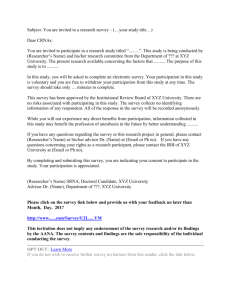

![[Date] [Policyholder Name] [Policyholder address] Re: [XYZ](http://s3.studylib.net/store/data/008312458_1-644e3a63f85b8da415bf082babcf4126-300x300.png)
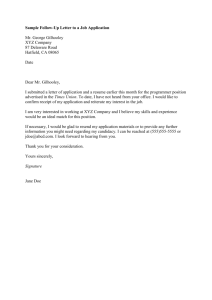
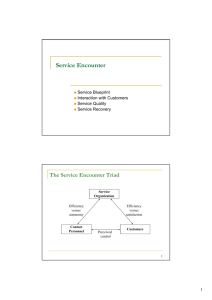
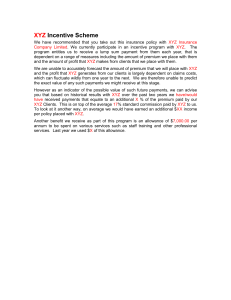
![waiver of all claims [form]](http://s3.studylib.net/store/data/006992518_1-099c1f53a611c6c0d62e397e1d1c660f-300x300.png)
